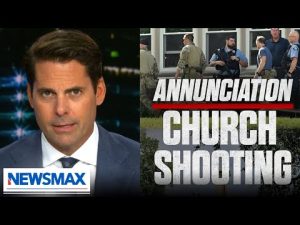This morning, an event unfolded in Minneapolis that brings to light the pressing issue of safety in places of worship. At 8:15 a.m., chaos erupted inside the Annunciation Catholic Church during a time when many were seeking solace through prayer. Instead of the peaceful ambiance typically found in a house of worship, the shocking sound of gunfire shattered the tranquility, targeting innocent lives. The scene was nothing short of horrifying, as children aged four to fourteen were present, praying and completely unaware that tragedy was about to strike.
Amidst the confusion, a courageous nine-year-old boy became a beacon of hope. When the bullets tore through the church’s stained glass windows, his best friend instinctively shielded him with his own body. This act of bravery is a reminder of the pure-hearted altruism of childhood, showcasing how, even in the darkest of moments, heroism can shine through. The young boy was left shaken but ultimately unharmed, while his friend sustained injuries that required hospitalization. Regrettably, two students—aged just eight and ten—lost their lives in this tragic attack, leaving their families and the entire community in mourning.
This heartbreaking incident has raised alarm bells, not just over the event itself, but over broader societal issues. With at least 17 people injured and many left grappling with the aftermath of witnessing such violence, the conversations that follow need to be meaningful and direct. Speculations about the shooter’s identity followed quickly after news broke. Reports identified the shooter as Robin Westman, a person who officials noted was born Robert Westman, which opens a conversation about mental health and the unique struggles faced by transgender individuals in society today.
What makes this situation even more unnerving is the context in which it transpired. The attack was labeled a hate crime targeting Catholics, as announced by the FBI’s director. This paints a disturbing picture of how religious individuals can be victims of targeted violence, particularly within a faith that preaches love and acceptance. It is a stark reminder of the growing tension in society, where even places of worship—a normal haven of safety—are no longer immune to hatred and violence.
Conversations about this event are bound to be complicated, and tackling them directly is essential. Many are understandably looking for answers, while others are trying to find a way to make sense of such a senseless tragedy. It is crucial to address mental health issues alongside discussions of community safety and the nature of violence. In a time where society is in dire need of connection and understanding, hearing the stories of those who experienced this tragedy firsthand gives voice to a reality many would prefer to overlook.
The symbolism of the stained glass window under which these children prayed adds another layer to the narrative. Depicting an angel safeguarding those below, it stands in stark contrast to the violence that occurred beneath its watchful eyes. Instead of a joyful return to a new school year, families are left to grapple with loss and fear. This incident may very well serve as a wake-up call that more needs to be done in the realms of both societal compassion and public safety, urging conversations that are long overdue in order to foster a world that prioritizes understanding and healing over division and pain.







